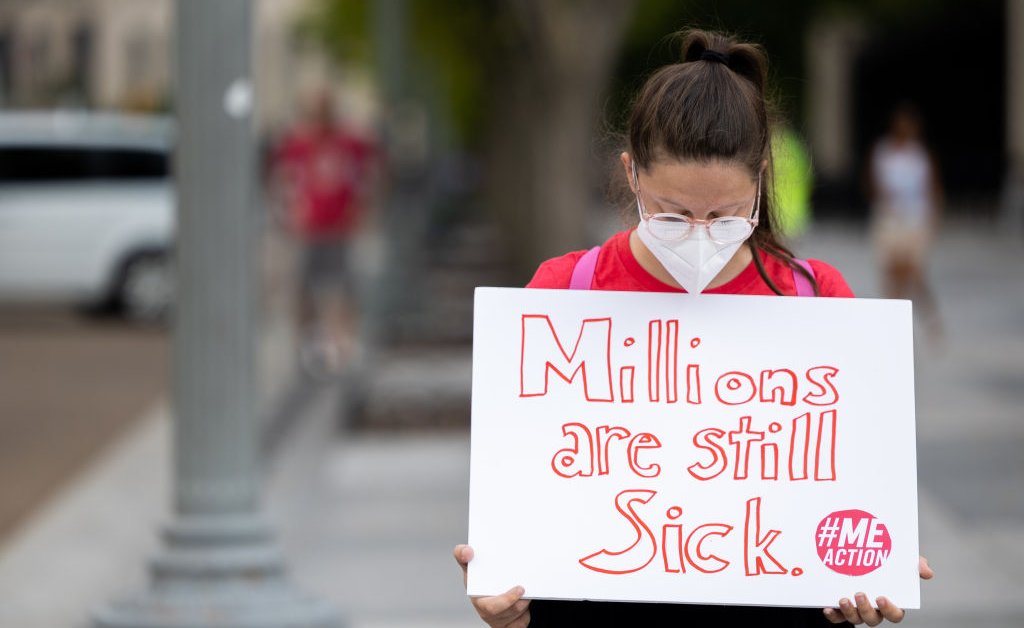In the 1980s, many people in the medical community treated chronic fatigue syndrome as a punchline. Some doctors dismissed patients’ debilitating symptoms, including crushing fatigue and crashes after exercise, as figments of their imaginations. Media outlets even dismissively nicknamed the condition “yuppie flu,” since many cases were reported among affluent white women.
In the infectious-disease clinic where Dr. Lucinda Bateman was at the time finishing her medical training, some doctors didn’t want to bother treating chronic-fatigue patients. When Bateman left to go into private practice, she remembers her old colleagues recording a message on their clinic’s answering machine, directing anyone with chronic fatigue syndrome to call Bateman so they wouldn’t have to get involved.
Despite the poor-taste joke, they were sending patients to the right person. Nothing about the condition (which is today called myalgic encephalomyelitis/chronic fatigue syndrome, or ME/CFS) was funny to Bateman. Her older sister developed ME/CFS after a string of health issues including strep throat and mononucleosis, and she knew how devastating it could be. Bateman dedicated her career to treating people with similar conditions and chasing the answer to a big question: why do seemingly innocuous viruses sometimes lead to devastating, long-lasting symptoms?
Almost three years into the pandemic, she has plenty of company on her quest for an answer. Millions of people around the world have developed Long COVID, or long-lasting symptoms that follow a case of COVID-19. Many of these symptoms look quite similar to the fatigue, cognitive decline, and crashes after exertion (formally known as post-exertional malaise, or PEM) observed among ME/CFS patients.
Studies also suggest that people who have survived COVID-19 are at increased risk of serious complications including heart and lung issues, dementia, kidney problems, and liver injury, compared to those who haven’t been infected. “SARS-CoV-2 is definitely a very pathogenic virus that attacks many, many aspects of the body,” Bateman says, because it’s able to bind to cells in various organ systems.
But SARS-CoV-2 is not unique in its ability to cause severe and widespread damage to the body. “There are a dozen other pathogens that are known to cause these post-acute-infection syndromes,” says Akiko Iwasaki, an immunobiologist at Yale University who recently co-authored a Nature review article on these conditions. “Some are very well studied, whereas others are not at all documented.”
Read More: You Could Have Long COVID And Not Even Know It
Viruses both routine and rare are linked to lasting complications, from vision loss and fibromyalgia to autoimmune disorders. Even common pathogens like influenza and Epstein-Barr (a cause of mononucleosis) come with potential long-term risks. Influenza can result in inflammation of the brain and heart, and Epstein-Barr is associated with Guillain-Barré Syndrome, a rare condition in which the body attacks its own nervous system, sometimes leading to paralysis. Both viruses are also believed to be possible ME/CFS triggers.
Viruses “have a range of being asymptomatic to being suddenly in the ICU,” Bateman says, “and from complete resolution to lingering, sometimes permanent problems.”
A recent study published in JAMA Network Open illustrates how frequently routine illnesses can lead to lingering issues. The researchers tracked 1,000 U.S. adults with COVID-like symptoms. About three-quarters of them tested positive for COVID-19, while the remaining people tested negative, suggesting they were likely sick with similar respiratory illnesses. After three months, almost 40% of those with COVID-19—and more than half of those who tested negative—reported ongoing physical or mental health problems, though it wasn’t possible to tease out exactly why. “People with all sorts of different communicable diseases do experience lasting negative impacts,” says co-author Lauren Wisk, an assistant professor at UCLA’s David Geffen School of Medicine.
Nonetheless, post-infectious conditions got little attention prior to the pandemic. As of 2018, less than one-third of U.S. medical schools taught students about ME/CFS, according to the U.S. Centers for Disease Control and Prevention (CDC), and ME/CFS researchers have worked with limited federal funding for years. In 2019, the National Institutes of Health (NIH) granted $15 million to study ME/CFS—a pittance, experts say, considering that the disease affects up to 2.5 million people in the U.S.
Post-viral illnesses often don’t have easily observable biomarkers that can be used for diagnosis or research, Bateman says. ME/CFS, for example, is evaluated not based on a single diagnostic test, but largely on a patient’s symptoms: if they’re unable to engage in pre-illness levels of activity for at least six months and experience symptoms including profound fatigue, PEM, and non-rejuvenating sleep, they may meet the criteria.
Symptoms don’t always tell the whole story, though. Research suggests ME/CFS can be triggered by multiple viruses (though it doesn’t always follow a viral infection), and it’s not always possible to tell when someone was infected, by what, and why it led to long-term symptoms.
“You can tell that the person’s sick,” Bateman says. “But you can’t link it to the initial infection very well.”
Those scientific challenges are real, and they have consequences that go beyond the laboratory. “People who’ve had these diseases for decades have been completely ignored by the medical community and scientific community,” Iwasaki says. “It’s swept under the rug, basically, because people can’t find an explanation for it.”
Add to the equation that most ME/CFS patients are women, whose symptoms are more often ignored by doctors, and “all these things converge to suppress the discussion around ME/CFS” and other post-viral conditions, Iwasaki says. “Whereas now,” with millions of people developing Long COVID around the same time, “we can’t suppress it anymore.”
Long COVID has brought about a fresh wave of interest in post-viral illness, as well as a $1.15 billion research budget from the NIH. Recent studies on Long COVID have raised a number of potential causes, from remnants of the virus lingering in the body to tiny blood clots cutting off oxygen flow to organs.
Another leading theory is that viruses like Epstein-Barr lie dormant in the body after an infection, then eventually become reactivated by another virus (like SARS-CoV-2) later in life and cause chronic symptoms, explains Dr. Nancy Klimas, director of the Institute for Neuro-Immune Medicine at Florida’s Nova Southeastern University and director of clinical immunology research at the Miami VA Medical Center. Research on people with both ME/CFS and Long COVID has raised this possibility.
Iwasaki’s research also suggests viruses may throw off the body’s circadian rhythms, which could in turn lead to hormone imbalances that cause post-viral symptoms. Her research has demonstrated that many Long COVID patients have abnormally low cortisol levels, which she says could contribute to symptoms like fatigue.
The hope, Bateman says, is that attention on and funding for Long COVID research will also lead to breakthroughs for people who have been suffering from post-infectious syndromes for years. “Long COVID researchers are asking the very same things that we’ve always asked about ME/CFS,” she says. “Now, instead of having a small number of researchers who were underfunded, we now have a massive number of researchers across all specialties and with really high levels of funding.”
That can be a double-edged sword. In Klimas’ view, all the attention on Long COVID has eclipsed some researchers’ long-standing efforts to understand ME/CFS and other post-viral illnesses. “Discouragingly, the ME/CFS research community have to turn their attention to Long COVID and they’re not writing their ME/CFS grants,” she says. Klimas is currently working on a CDC-funded study that compares people with Long COVID to those who have ME/CFS, with the hope of uncovering similarities and differences between the conditions, but she says similar proposals from her lab have recently been rejected by the NIH.
Whether researchers focus on Long COVID or longer-standing syndromes, it could take years for their findings to translate to treatments. That underscores the importance of preventing as many viral infections as possible now, so people don’t go on to develop complications later. Masking and ventilation still go a long way in preventing infection, Iwasaki says, as could innovations like nasal vaccines for COVID-19 and a vaccine for Epstein-Barr, both of which are in development now.
Klimas says the public also needs a better understanding of the range of outcomes associated with viruses. Many people treat common viral infections like annoyances, more than real health threats, and push through them to get back to work, school, or the gym. But Klimas says her decades of experience with ME/CFS suggest that rushing to return to normal can overtax the body and contribute to complications.
“It really matters how you treat yourself after an acute infection,” she says. “You have to listen to your body when [you’re ill] and not try to come back quickly and get right back into your pre-sick schedule.”
It’s important to make progress in both public awareness and scientific research now, she says—not only for people who may come down with COVID-19 or the flu this winter, but for those who may get sick in the future.
“There will be another pandemic or some other virus,” Klimas says, “and there will be consequences.”
More Must-Reads From TIME



